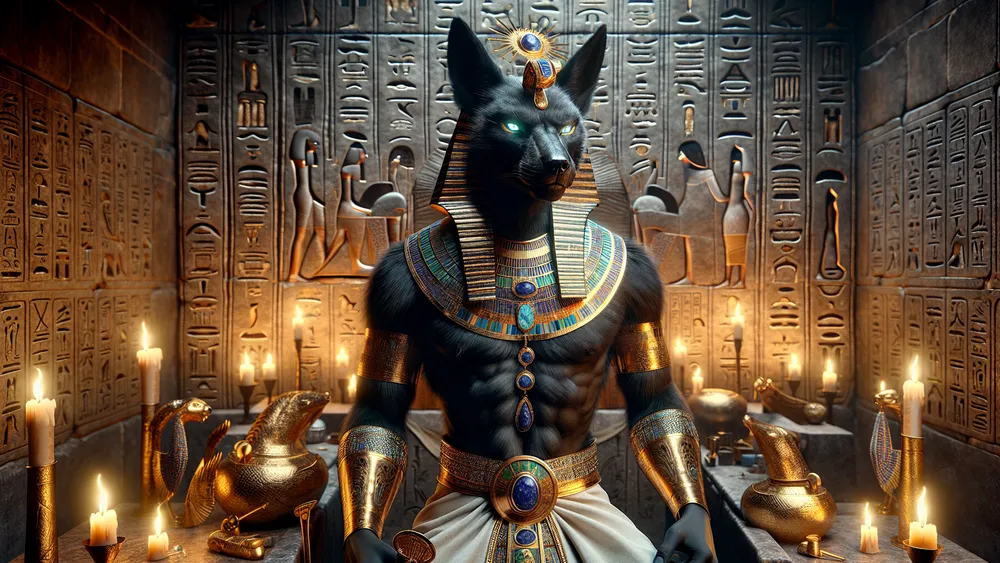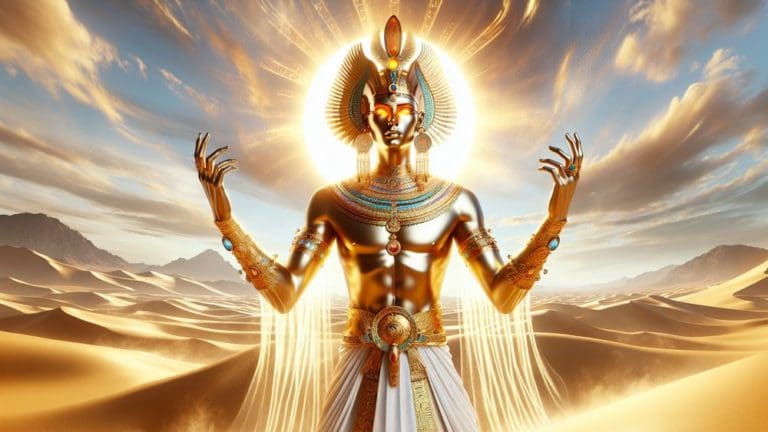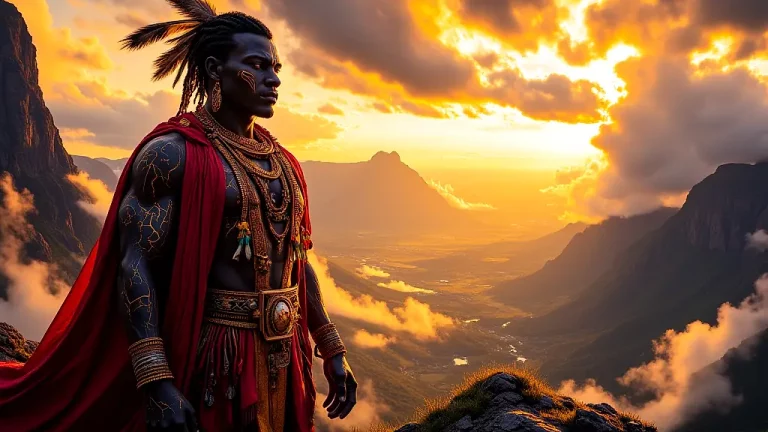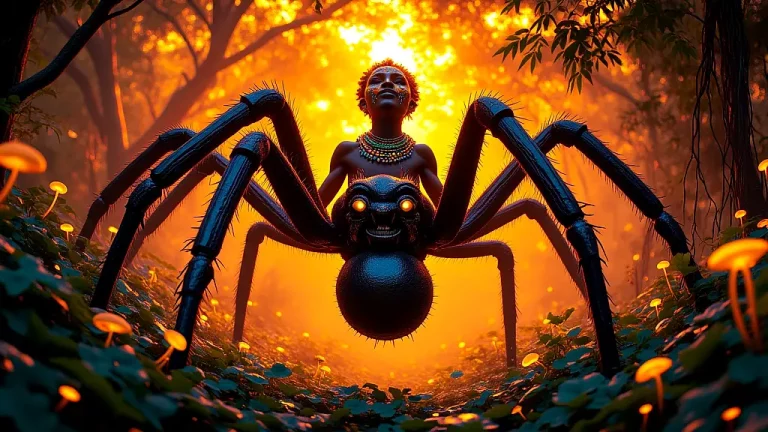Khenti-Amentiu: Ancient Egyptian Jackal Deity
Welcome to our look into Khenti-Amentiu, who is an interesting figure in old Egyptian myths. Think of a guard at the start of the afterlife, just like a guard at the doors of a very large building. Khenti-Amentiu, he is shown as a jackal, did an important job in the religious lives of the old Egyptians.
Key Points:
- Khenti-Amentiu, an ancient Egyptian deity, was known as the Foremost of the Westerners or Chief of the Westerners.
- Initially a local god of the dead, Khenti-Amentiu later became linked with Osiris, playing a role as a guard of the dead.
- He was worshipped mainly in Abydos, an essential religious site in ancient Egypt, where rituals and ceremonies were performed for the dead.
- Khenti-Amentiu’s role evolved over time, transitioning from a local guardian to a prominent figure in Egyptian mythology.
- Depicted as a jackal, symbolizing protection and guidance in the afterlife, he was a key deity in Egyptian beliefs about death and the underworld.
- Khenti-Amentiu’s influence extended to Greco-Roman religion, impacting beliefs about the afterlife and soul protection.
But in this blog, we will look at the beginnings, changes, and meaning of this god. We will see how his role changed through time, and his link with the more well-known god Osiris, also his tasks post-life.
Also, we will check out the art showing him, and the ways people showed he mattered, and how he affected other folks and how he stays remembered. For those who are new to these old stories from Egypt or those wanting more knowledge, this detailed guide will give you a close look at his spot in the rich mix of old Egyptian ideas.
Khenti-Amentiu: Overview and Key Facts
| Key Point | Description |
|---|---|
| Name | Khenti-Amentiu (sometimes spelled Khenty-Amentiu) |
| Meaning of Name | “Foremost of the Westerners” or “Chief of the Westerners” |
| How He Is Shown | Often shown as a jackal or a man with a jackal head |
| What Jackal Means | The jackal means protection, guidance, also the afterlife |
| Role in Stories | At first, a local god of the dead, then linked with Osiris |
| Main Place of Worship | Abydos, also one of the most important religious places in old Egypt |
| Link with Osiris | Later joined into the Osiris stories, acting as a guard of the dead |
| Job in Afterlife | Guard of the dead, seeing they travel safe to the next life |
| Historical Change | From a local god to a main figure in the Egyptian gods list |
| How People Worshiped | Involves rites, gifts, and events meant for the dead |
| Seen in Art | In tomb art, statues, and many old items |
| Effect on Other Cultures | Affected Greco-Roman religion and beliefs |
| Lasting Fame | Still an interesting topic in today’s culture and school studies |
Where Khenti-Amentiu Came From
To see where Khenti-Amentiu came from and early images of him, we need to look into the old Egyptian art and words that first brought in this puzzler god.
Early Pictures and Meanings
The early pictures of Khenti-Amentiu came from the Predynastic and Early Dynastic periods in old Egypt. He was shown as a jackal or a man with a jackal head, often. You can see these images in tomb paintings and carvings; they act as guardians for the dead. The jackal, an animal often seen around graveyards, was a natural sign for a god linked with the dead.
In Egyptian culture, the jackal meant protection and guidance, much like a shepherd watching over them. This sign is important in understanding Khenti-Amentiu’s role in making sure souls get to the afterlife safely.
Key elements in these early pictures include:
- Jackal Form: Meaning vigilance and guarding.
- Tomb Paintings: Showing his role in rituals for the dead.
- Carvings and Statues: Stressing his protective side.
These artistic pictures set up the base for Khenti-Amentiu’s changing part in Egyptian myths.
Khenti-Amentiu was often represented as a jackal in ancient Egyptian art, symbolizing protection and guidance for the deceased on their way to the afterlife.
How Khenti-Amentiu’s Job Changed Over Time
Khenti-Amentiu’s job in Egypt stories changed quite a lot over time. At first, he was a local god tied to the big graveyard of Abydos. That was one of the earliest and really important burial places in Egypt. When Upper and Lower Egypt joined around 3100 BCE, the religious scene started to shift. So, Khenti-Amentiu’s role grew larger. He moved from watching over a particular burial area to guarding dead people in general.
Think of this like a small-town hero becoming a national figure because of big events. The fact Abydos got more important as a religious spot raised Khenti-Amentiu’s status, making him more prominent in the group of Egyptian gods. Key historical times and events were important in this development. During the Old Kingdom (about 2686–2181 BCE), the Osiris cult grew, affecting Khenti-Amentiu’s job.
As Osiris became central in Egyptian burial beliefs, Khenti-Amentiu got blended into the Osiris stories. Often he was seen as a helper or side of Osiris. This blending wasn’t sudden but gradual and driven by the political and religious shifts of the time.
The Middle Kingdom (around 2055–1650 BCE) saw Khenti-Amentiu getting more into state-endorsed religious activities, setting his place firmly as a guide and protector of the dead.
Important points in this change include:
- Unification of Egypt: Spread Khenti-Amentiu’s role beyond Abydos.
- Rise of the Osiris Cult: Brought Khenti-Amentiu into the broader stories.
- State-Sponsored Religion: Made his role official in religious practices.
These changes show how Khenti-Amentiu moved from a small-time guardian to a key god within the Egyptian gods, reflecting the changing nature of old Egyptian religious beliefs.
Khenti-Amentiu in Egyptian Stories and Beliefs
As we move on from looking at Khenti-Amentiu’s changing job in Egyptian stories, now let’s check out the particular stories and beliefs about this mysterious god.
Connection with Osiris
The link between Khenti-Amentiu and Osiris is an interesting part of old Egyptian stories. At first, Khenti-Amentiu was a different god, but he slowly became part of Osiris’s stories as Osiris’s cult grew more famous. This change is like a side character in a story becoming a main part of the plot.
Khenti-Amentiu, who started as a guardian of the dead, was seen later as an integral part or companion of Osiris, the god of the afterlife. When looking at this, it shows how Egyptians believed gods were linked, especially in their jobs connected to the afterlife. Therefore, Khenti-Amentiu’s job of guarding and guiding the dead worked well with Osiris’s role as the ruler of the underworld.
Key elements of this link include:
- Integration into Osiris Stories: Khenti-Amentiu connected with Osiris, which raised his importance.
- Complementary Jobs: Both gods worked together to make sure souls passed safely and were judged.
- Symbol of Guarding: Khenti-Amentiu’s jackal form showed vigilance, which lined up with Osiris’s afterlife job.
This mix shows how Egyptian stories about gods could change and gods could blend into new roles as religious ideas changed.

Job in the Afterlife
In the afterlife, Khenti-Amentiu had an important job as a protector and guide for dead people. He had to make sure dead souls got to the afterlife safely, like a guide showing travelers through a dangerous trip. Shown as a jackal or a man with a jackal head, he was about vigilance and protection. He watched over funeral rites and made sure dead people were ready for the underworld trip.
This included guarding tombs and bodies inside, stopping any damage or disturbance. People knew that with him, their loved ones would be cared for in the afterlife.
To understand Khenti-Amentiu’s job, we can compare him to other afterlife gods like Anubis and Osiris. Anubis mainly did body preparing and preserving, while Osiris was the underworld ruler and judged the souls. But Khenti-Amentiu looked out for the dead and guided them. The table below shows their roles:
| Deity | Main Job in the Afterlife | Symbolism |
|---|---|---|
| Khenti-Amentiu | Protector and guide for dead people | Jackal, protection |
| Anubis | Preparing bodies, body preserving | Jackal, preservation |
| Osiris | Underworld ruler, soul judge | Crook and flail, coming back to life |
This shows the different but working-together jobs these gods had to make sure dead souls were safe and well. It reflects how complex and many-sided old Egyptian ideas about death and afterlife were.

Places Where Khenti-Amentiu Was Worshipped
Khenti-Amentiu was mainly honored in Abydos, which was one of the most important religious places in old Egypt. Abydos was thought to be an entrance to the afterlife, so it was a good place for worshiping a god connected with the dead. The steps and events for Khenti-Amentiu closely linked with those for Osiris, showing their strong link.
People did ceremonies to respect Khenti-Amentiu, asking for his safety for the dead and making sure they had a safe trip to the afterlife. This can be similar to today’s religious events where people pray for their loved ones’ well-being.
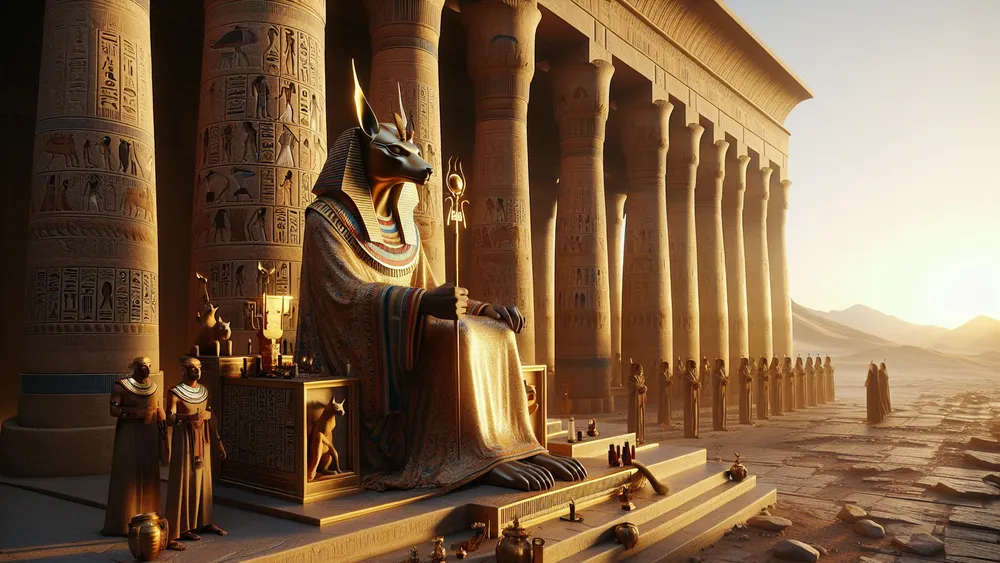
Key parts of Khenti-Amentiu’s worship included:
- Offerings: People brought food, drink, and other gifts to his shrines.
- Funeral Steps: Special actions took place to call for Khenti-Amentiu’s safety over the dead.
- Festivals: Yearly celebrations were held for his role in the afterlife, often with Osiris.
These steps show how important Khenti-Amentiu was in old Egyptians’ religious life, especially in their thoughts about death and the afterlife.
Worship of Khenti-Amentiu in Abydos involved offerings, funeral rituals, and festivals, emphasizing his crucial role in ancient Egyptian beliefs about the afterlife.
How Khenti-Amentiu Is Shown in Art
After looking at places where Khenti-Amentiu was honored, let’s check out how this god was shown in old Egyptian art and objects.
Artistic Pictures and Sculptures
Khenti-Amentiu is often shown in old Egyptian art, usually as a jackal or a man with a jackal head, meaning he looks out for the dead. These art pictures are found in different ways, like wall paintings, carvings, and statues. What is common in showing Khenti-Amentiu is his jackal shape, which means vigilance and safety, and his link to burial settings. For instance, in many tomb paintings, Khenti-Amentiu looks over the burial steps, making sure the dead are safely going to the afterlife. These pictures are like how modern symbols, for example, the Statue of Liberty, stand for freedom and safety. Main things in Khenti-Amentiu’s art pictures include:
- Jackal Head: Meaning vigilance and safety.
- Burial Scenes: Often shown in settings about burial and the afterlife.
- Guarding Position: In a protecting stance, showing his job as a protector.
These art parts show the importance of Khenti-Amentiu in old Egyptian life and his longtime role as a guardian of the dead.
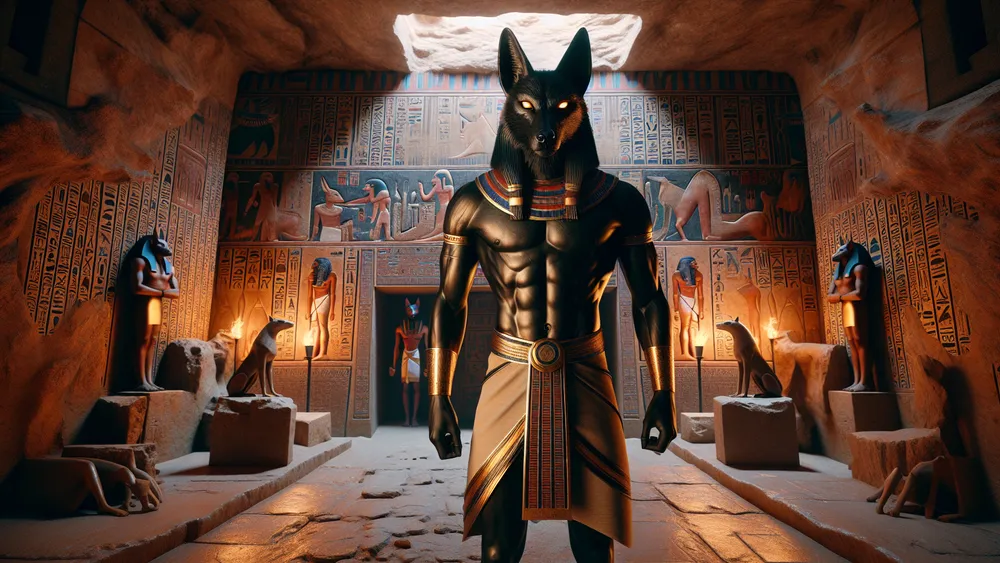
Statues and Artifacts
The statues and artwork linked with Khenti-Amentiu give very valuable ideas about his job and honor in old Egyptian life. Important finds include detailed statues showing Khenti-Amentiu as a jackal or a man with a jackal head, found often in tombs and temples. These statues were not only for looks; they stood for safety, making sure the dead were safe in the afterlife.
For instance, a kept-in-good-shape statue of Khenti-Amentiu was found in Abydos, showing his importance in this big honor place. The importance of these artworks is like how old things today help us understand the beliefs and thoughts of past groups. Some things connected with Khenti-Amentiu are:
- Jackal-Headed Statues: Means looking out and safety.
- Burial Amulets: Used to call for Khenti-Amentiu’s safety over the dead.
- Temple Carvings: Showing Khenti-Amentiu in scenes about the afterlife.
These artworks show the skill of old Egyptian makers and give a better idea of Khenti-Amentiu’s lasting role as a guardian of the dead.
Khenti-Amentiu’s Impact on Other Cultures
After looking at the art pictures and objects of Khenti-Amentiu, now we check out how this old god affected other cultures and left a lasting mark beyond Egypt.
Impact on Greco-Roman Religion
Khenti-Amentiu’s reach went beyond Egypt, changing Greco-Roman religious acts and thoughts through cultural sharing and mixing. As Greeks and Romans met Egyptian gods, they often took in these gods into their own group of gods, a way called mixing.
Khenti-Amentiu, with his job as protector of the dead, was sometimes linked with similar gods in Greco-Roman places, such as Hades and Hermes, who also had jobs connected to afterlife and soul safety.

While modern cultures take on and change outside ways, making a mixed group of shared ways, so did ancient ones. Important parts of this mixing are:
- Link with Hades: Both gods were seen as rulers or protectors of the afterlife.
- Mixing with Hermes: Hermes, guiding souls, shared things with Khenti-Amentiu in leading souls to the afterlife.
- Cultural Sharing: The sharing of religious thoughts during times of Greek and Roman rule in Egypt allowed this mixing.
These interactions show the changeable nature of old religious thoughts and the lasting mark of Khenti-Amentiu in shaping the spiritual ways of the Greco-Roman places.
Modern Views and Lasting Influence
In today’s world, Khenti-Amentiu keeps catching the mind, seen in different forms of popular culture. From books and movies to video games, this old god often gets shown as a strange and strong guardian of the dead. Much like old stories inspire new ones, his ongoing influence also stays in current religious and spiritual acts.
People sometimes call on him in ceremonies related to safety and the afterlife.
For example, modern pagan and Egyptian religion revival followers might include Khenti-Amentiu in their group of gods, honoring him with gifts and requests. Important parts of Khenti-Amentiu’s modern impact are:
- Popular Culture: Seen in books, movies, and video games as a guardian role.
- Spiritual Acts: Added to modern pagan and Egyptian religion revival ceremonies.
- Symbol of Safety: Kept respect as a protector of the dead and afterlife.
These modern ideas and acts show the lasting impact of Khenti-Amentiu, proving how old gods can keep affecting and inspiring across a long time.
Big Picture of Egyptian Gods
The Egyptian group of gods is a complicated and interesting picture of gods, each with their own special jobs and features. Khenti-Amentiu, as a keeper of the dead, fits into this bigger system along with other important gods like Osiris, Anubis, and Ra.
To see how connected these gods are, you might think of a big family, where every member has their jobs and connections with each other. For a full look at all the Egyptian gods, you can check this list of all the Egyptian gods.
This wider view helps to see the full and detailed stories that have caught the interest of people for a very long time.
FAQs
1. Who was Khenti-Amentiu in ancient Egyptian mythology?
Khenti-Amentiu in ancient Egyptian mythology was a jackal-headed deity associated with the afterlife and the god Osiris.
2. How did Khenti-Amentiu’s role change over time?
Khenti-Amentiu’s role changed over time from being a local deity associated with the necropolis of Abydos to becoming integrated into the broader Osiris mythos as a guardian of the afterlife.
3. What is the significance of Khenti-Amentiu’s association with Osiris?
The significance of Khenti-Amentiu’s association with Osiris lies in his role as a precursor to Osiris in the realm of the dead, eventually merging with Osiris to symbolize the continuity and evolution of funerary deities in ancient Egyptian religion.
4. Where were the main cult centers dedicated to Khenti-Amentiu?
The main cult centers dedicated to Khenti-Amentiu were primarily located in Abydos.

